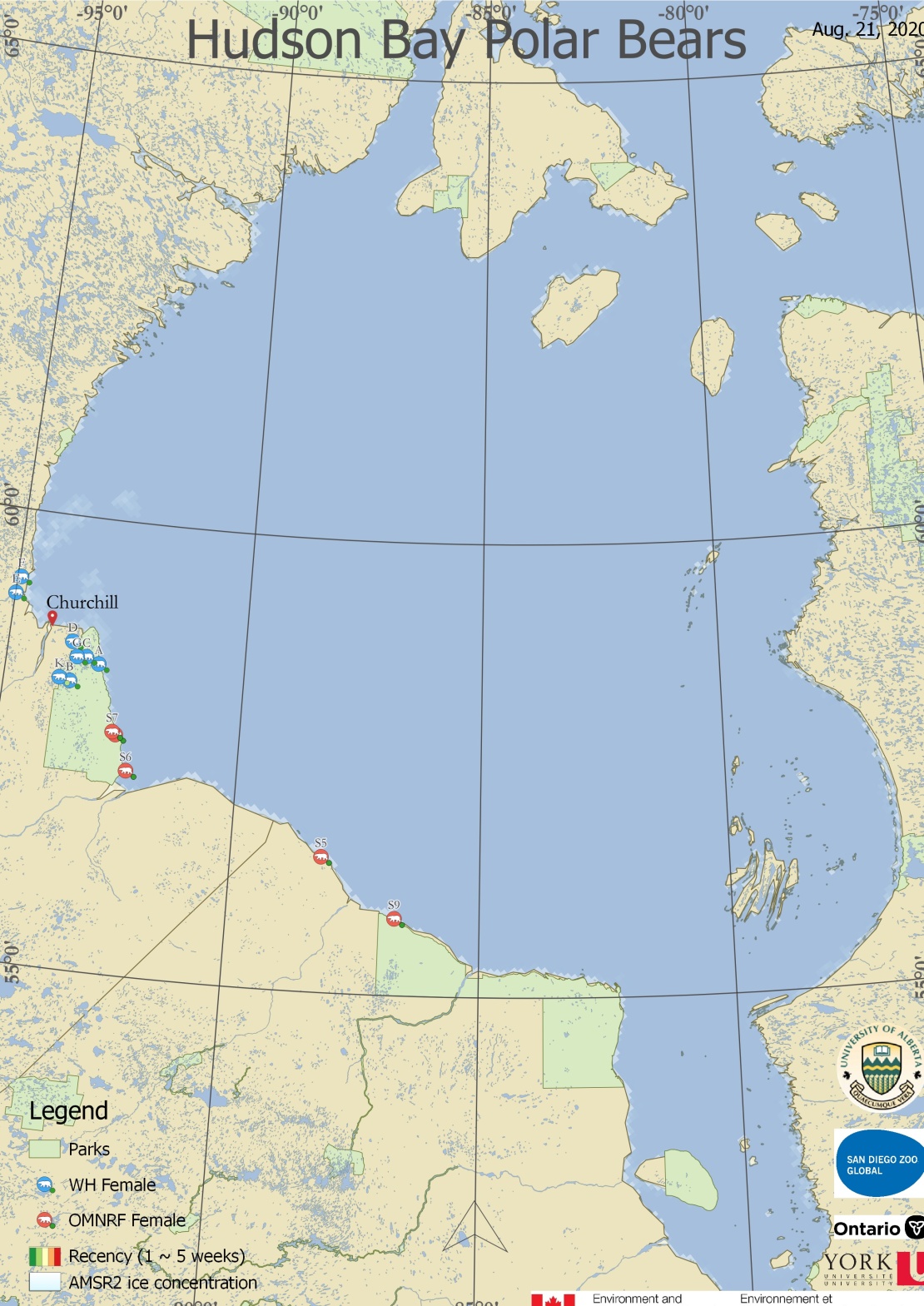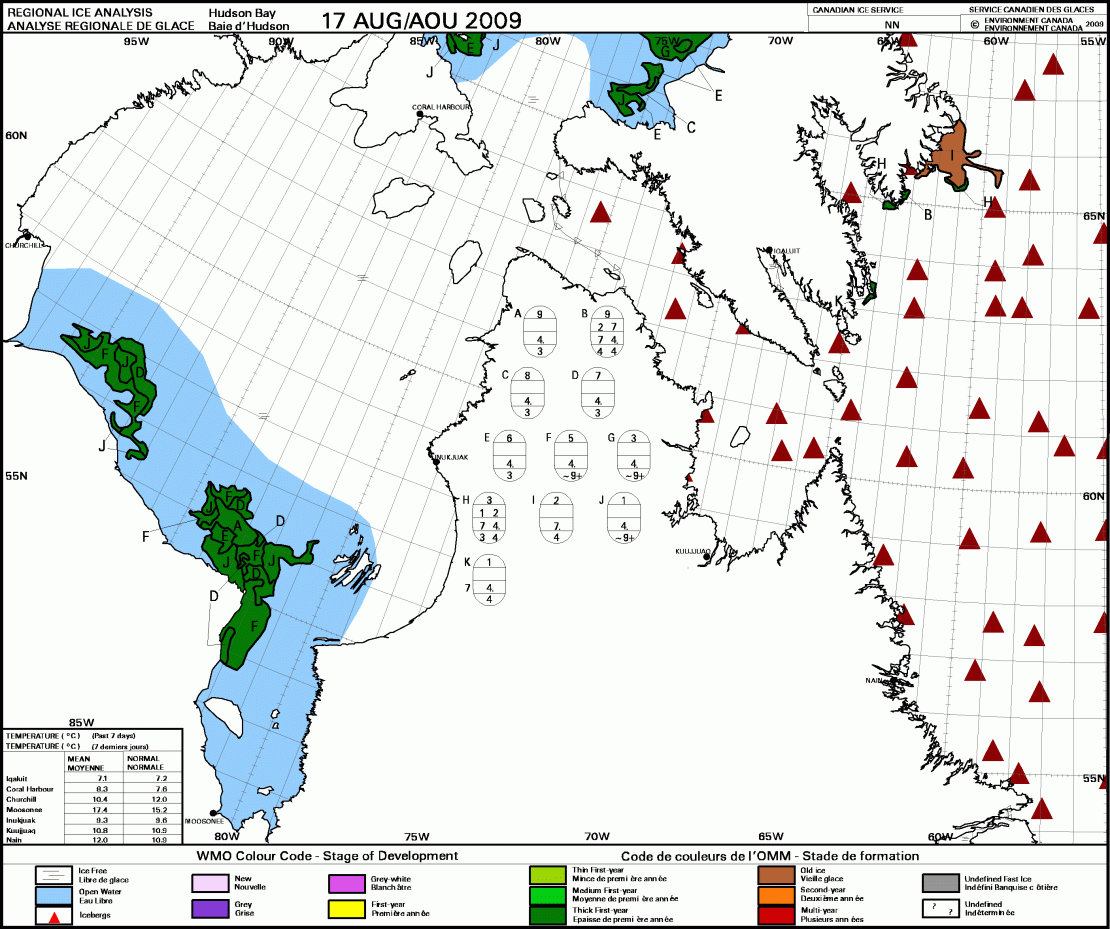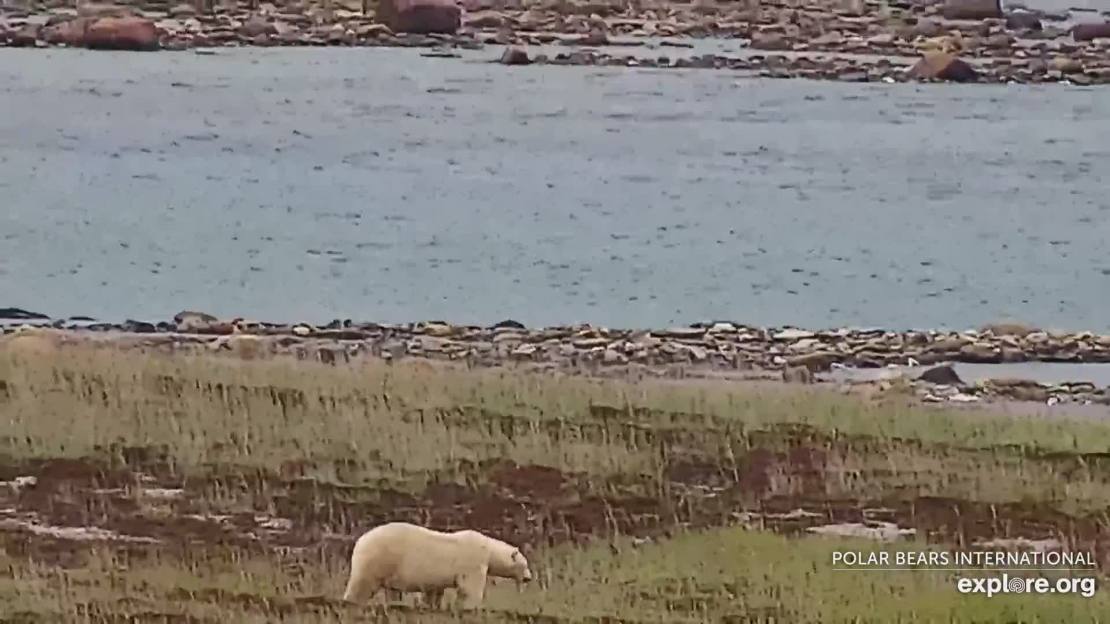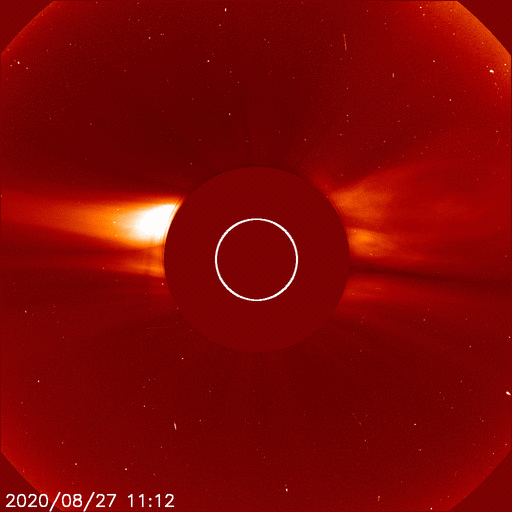Reposted from Dr. Susan Crockford’s Polar Bear Science
Posted on August 27, 2020 |
Amid crying over low Arctic ice, W Hudson Bay polar bears leave ice as late as 2009
This year, the last collared Western Hudson Bay polar bear to leave the ice left as late, or later, than the last collared bear did in 2009 (which was an unusually late breakup year) and so far, all bears spotted have been in good physical condition despite inhabiting one of the most southern regions of the Arctic. All the while, sea ice experts have been hand-wringing about low Arctic sea ice –– in general and as polar bear habitat.
A female with two yearling cubs on the shore of Wakusp National Park, Western Hudson Bay on 24 August 2020. Taken via livecam from almost a mile away.
By the third week of August this year, there was only a small patch of ice evident off Churchill in Western Hudson Bay, see below:

However, at least one bear with a satellite tracking collar stayed on that bit of ice until about 21 August, see tracking map below provided by Andrew Derocher, University of Alberta:

Said Derocher (22 August 2020) about the late date breakup and delays coming ashore: “One good year doesn’t help the population much but it’s better than a bad year.” Except he said something similar last year after admitting conditions had been good and like the 1980s, which he now seems to have forgotten. As of this summer, WH polar bears have now had six good years by any unbiased measure of the concept: ‘one good year’, year after year.
2020 vs. 2009
The last time that polar bears in Western Hudson Bay came off the ice so late in the summer was in 2009. Breakup of sea ice on Western Hudson Bay was unusually late and bears accordingly came ashore much later than the previous two decades – but even still, as far as I can tell from the published data (Cherry et al. 2013; Castro de la Guardia et al. 2017), the last collared bear came off the ice in 2009 on about August 19 or 20 (Day 231 or 232). Derocher announced his last bear came ashore on or about 21 August in 2020.

Condition of bears
Below is a video taken from a distance by one of the livecams on the shore of Wakusp National Park southeast of Churchill in Western Hudson Bay on 24 August 2020. This female with two cubs in good condition (the same group as in the still shot above) got spooked by something – probably a male bear approaching – and took off at a run across the tundra. But watch which of the three bears was first to notice something was up.
On 26 August, along the same stretch of shoreline, a solitary fat bear wandered by:

Polar Bear Alert Program Weekly Reports
Oddly, there has still been no first report of the season from the polar bear alert program. On Tuesday (25 August), I phoned Manitoba Conservation and the person I talked to said conservation officers had only just been sent out to Churchill this week. He didn’t say if this was a Covid-19 delay or whether there had been no need until now. However, it does suggest we won’t see a report until next week with some kind of assessment of how the bears are doing.
Arctic sea ice
Just to balance the above, it is certainly true that sea ice cover over the Arctic is near its yearly low. However, there is still quite a lot of ice left at 27 August 2020:

Keep in mind when you hear all the ‘sky is falling’ rhetoric that sea ice returns in the fall, as it did even after the lowest and second-lowest summer ice extents since 1979 (in 2012 and 2007/2016, respectively), see ice cover below at 15 November 2016, two months after a low at 15 September.

During this time of ice retreat, most bears endure a 4-5 month fast whether they are onshore or spend the summer on the remaining ice. But that’s OK, because all polar bears can survive and even thrive with a summer fast of 4-5 months as long as they get enough to eat during the spring (Crockford 2017, 2019).
References
Castro de la Guardia, L., Myers, P.G., Derocher, A.E., Lunn, N.J., Terwisscha van Scheltinga, A.D. 2017. Sea ice cycle in western Hudson Bay, Canada, from a polar bear perspective. Marine Ecology Progress Series 564: 225–233. http://www.int-res.com/abstracts/meps/v564/p225-233/
Cherry, S.G., Derocher, A.E., Thiemann, G.W., Lunn, N.J. 2013. Migration phenology and seasonal fidelity of an Arctic marine predator in relation to sea ice dynamics. Journal of Animal Ecology 82:912-921. http://onlinelibrary.wiley.com/doi/10.1111/1365-2656.12050/abstract
Crockford, S.J. 2017. Testing the hypothesis that routine sea ice coverage of 3-5 mkm2 results in a greater than 30% decline in population size of polar bears (Ursus maritimus). PeerJ Preprints 19 January 2017. Doi: 10.7287/peerj.preprints.2737v1 Open access. https://peerj.com/preprints/2737/
Crockford, S.J. 2019. The Polar Bear Catastrophe That Never Happened. Global Warming Policy Foundation, London. Available in paperback and ebook formats.
And what about bears in the rest of the arctic? Where apart from the Beaufort Sea, ice in all areas is at record low levels? (Overall it is at second lowest for the date).
This looks to me like someone trying to divert attention.
Ice in Hudson Bay was invisible to satellite photos by August 15th.
Look, where the “Polarstern” position is
Thanks Krishna, very interesting link.
In an other post I showed you the ice thickness beeing higher than last year 😀
But data isn’t what you are interested in, I know 😀
PS – had just to look up:
Ice thickness
Griff,
I see that you ducked her post, to bring in a deflection.
LOL
Griff, how long is your record?
Record low everywhere?
http://masie_web.apps.nsidc.org/pub/DATASETS/NOAA/G02186/plots/4km/r02_Chukchi_Sea_ts_4km.png
http://masie_web.apps.nsidc.org/pub/DATASETS/NOAA/G02186/plots/4km/r03_East_Siberian_Sea_ts_4km.png
http://masie_web.apps.nsidc.org/pub/DATASETS/NOAA/G02186/plots/4km/r05_Kara_Sea_ts_4km.png
http://masie_web.apps.nsidc.org/pub/DATASETS/NOAA/G02186/plots/4km/r07_Greenland_Sea_ts_4km.png
http://masie_web.apps.nsidc.org/pub/DATASETS/NOAA/G02186/plots/4km/r09_Canadian_Archipelago_ts_4km.png
http://masie_web.apps.nsidc.org/pub/DATASETS/NOAA/G02186/plots/4km/r10_Hudson_Bay_ts_4km.png
The bears are doing great all over the arctic. Perhaps if you read some actual scientists instead of paid activists, you might have known that already.
I see griff is still desperately trying cherry pick some piece of information so that he can ignore all the good news.
Well, what he’s doing is simply repeating the same line over and over, Goebbels-style, regardless of correction.
That’s the thing about these progressives – they stick to their playbook.
“ice in all areas is at record low levels?” …… NOWHERE
Levels are still far above the norm for the last 10,000 years
Stop DENYING that fact, griff.
Comparing now to levels in the late 1970s that were an extreme high anomaly, makes you look more and more like an ignorant climate denialist.
The number of year in the period you think was “normal”, is still way above your apparent IQ.
@griff
look at the data, could be, Arctic seaice melt is over for this year 😀
TypoTitle:
Amid crying over low Arctic ice, W Hudson Bay polar bears leave ice as late as 2009
2009???????
OK I guess it makes sense
<a href="https://follow.mosaic-expedition.org/Source, date Friday, August 28 2020
PBs eat seals.
Seals eat fish.
Fish eat krill.
Krill eat phytoplankton.
Phytoplankton bloom in the Summer and Fall sun-exposed waters.
Repeat.
An alternative is also
walruses as PB food.
Walruses eat mollusks.
Mollusks are filter feeders
Mollusks (clams) eat plankton.
Repeat.
Everything in the Arctic marine environment depends on the sunlight-driven, primary productivity of the sunlit months of open water that feeds the entire food chain. And study after study of remote-sensing on phytoplankton shows the Arctic primary productivity is increasing.
But how can all that happen without some environmentalist to micromanage and babysit it?
With plenty of OPM.
Plankton are plants, they also need carbon dioxide, more the better. All plants need sunlight, water and carbon dioxide. More CO2 benefits the whole biosphere.
The MOSAiC expedition got some great pictures of long dangling festoons of algae hanging from the underside of the ice. Even with the ice three feet thick enough sunlight got through to grow stuff. Where other oceans are more sterile away from shore because seaweed has nothing to grow on, sea-ice allows arctic waters to be more fertile than anyone suspected.
Save the Krill
My son was harassed by a “Save the Whale” protester and he told them he was a member of “Save the Krill”. Then explained how whales were destroying the krill in record numbers and something had to be done about it. That her whales were complicit in a horrible environmental and ecological disaster.
So Save the Krill.
Two thumbs, way up!!
Reminds me of my cousin with his “Save the Naugadog, ban naugahyde” T shirt.
Walking down a street or at the mall, there were plenty folks who pointed and snickered.
He did have a few folks who raised their fists and said they agreed with him; “Ban naugahyde”.
OH THE BEARMANITY!!
So, if I understand the title, polar bears left the ice in 2009 and have been crying since. That’s really sad.
Before Venezuela became a s-hole, the national beer was Polar. With, you guessed it a polar bear as a mascot. So when we had to work late and miss happy hour, the saying was: “El oso está llorando” (The bear is crying).
I know the son of the original brew master from Germany. Cheers.
Dutch gentleman killed by polar bear at Svalbard. Was camping, attacked while sleeping in his tent.
https://www.vg.no/nyheter/innenriks/i/P9WXwR/johan-38-drept-av-isbjoern-paa-svalbard
First leatal attack since 2011, authorities complaining people get slack and forget to carry guns.
Man goes to sleep in tent
Tent is in polar bear territory
Polar bear is in polar bear territory
Farewell and adieu my fair Spanish ladies………
Lol! your gonna need a bigger tent…. 😉
Yes but 2009 was not a leap year like 2020. So there’s that…
Still, 2009 was not a leap year like 2020. So there’s that…
Cuddly creatures, like having those ‘orible humans for breakfast, so if in Spitsbergen watch out, someone got killed there the other day . on the other hand you could admire the aurora that has started within the last 3 hours

http://www.n3kl.org/sun/images/noaa_kp_3d.gif
caused by a yesterdays CME (coronal mass ejection) from the sun
A polar bear has killed a man in Norway’s Arctic Spitsbergen island, local officials say.
https://www.bbc.co.uk/news/world-europe-53945950
maybe just doin his part to save the bears…
What is the common denominator between 2009 and 2020? Both are solar minimum years. Without an El Nino in sight, expect more sea ice growth and bears coming off the ice late again in 2021.
https://www.google.com/amp/s/nypost.com/2020/08/29/get-naked-how-to-fend-off-a-polar-bear-attack/amp/